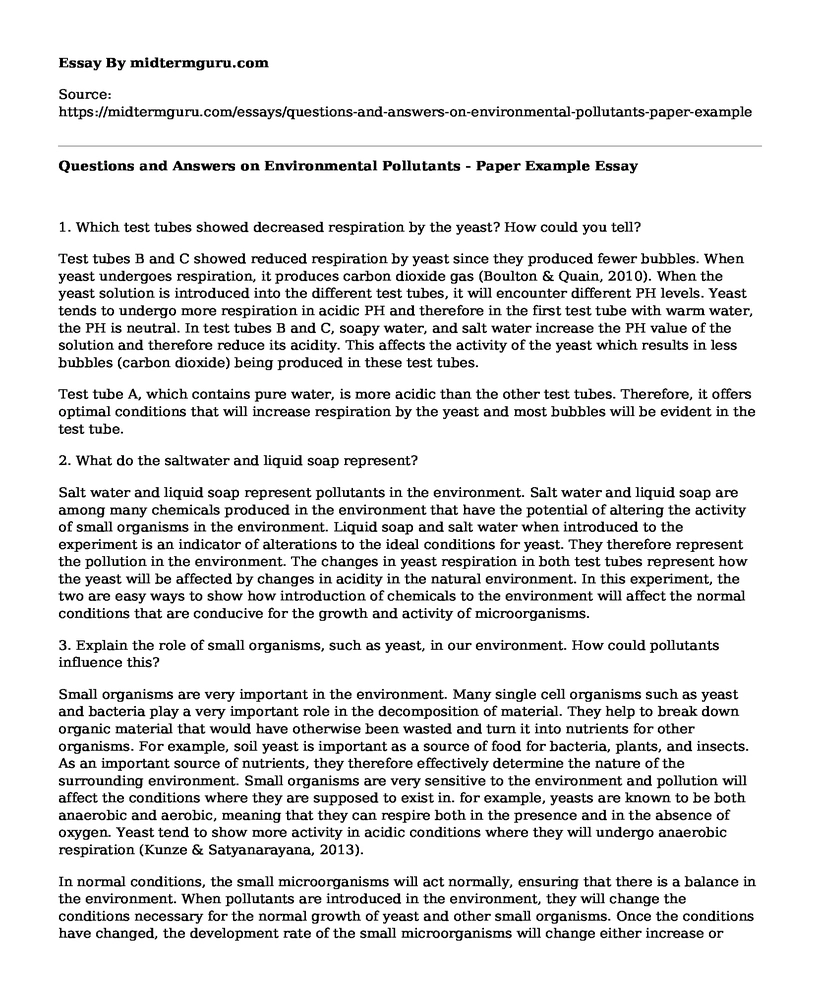1. Which test tubes showed decreased respiration by the yeast? How could you tell?
Test tubes B and C showed reduced respiration by yeast since they produced fewer bubbles. When yeast undergoes respiration, it produces carbon dioxide gas (Boulton & Quain, 2010). When the yeast solution is introduced into the different test tubes, it will encounter different PH levels. Yeast tends to undergo more respiration in acidic PH and therefore in the first test tube with warm water, the PH is neutral. In test tubes B and C, soapy water, and salt water increase the PH value of the solution and therefore reduce its acidity. This affects the activity of the yeast which results in less bubbles (carbon dioxide) being produced in these test tubes.
Test tube A, which contains pure water, is more acidic than the other test tubes. Therefore, it offers optimal conditions that will increase respiration by the yeast and most bubbles will be evident in the test tube.
2. What do the saltwater and liquid soap represent?
Salt water and liquid soap represent pollutants in the environment. Salt water and liquid soap are among many chemicals produced in the environment that have the potential of altering the activity of small organisms in the environment. Liquid soap and salt water when introduced to the experiment is an indicator of alterations to the ideal conditions for yeast. They therefore represent the pollution in the environment. The changes in yeast respiration in both test tubes represent how the yeast will be affected by changes in acidity in the natural environment. In this experiment, the two are easy ways to show how introduction of chemicals to the environment will affect the normal conditions that are conducive for the growth and activity of microorganisms.
3. Explain the role of small organisms, such as yeast, in our environment. How could pollutants influence this?
Small organisms are very important in the environment. Many single cell organisms such as yeast and bacteria play a very important role in the decomposition of material. They help to break down organic material that would have otherwise been wasted and turn it into nutrients for other organisms. For example, soil yeast is important as a source of food for bacteria, plants, and insects. As an important source of nutrients, they therefore effectively determine the nature of the surrounding environment. Small organisms are very sensitive to the environment and pollution will affect the conditions where they are supposed to exist in. for example, yeasts are known to be both anaerobic and aerobic, meaning that they can respire both in the presence and in the absence of oxygen. Yeast tend to show more activity in acidic conditions where they will undergo anaerobic respiration (Kunze & Satyanarayana, 2013).
In normal conditions, the small microorganisms will act normally, ensuring that there is a balance in the environment. When pollutants are introduced in the environment, they will change the conditions necessary for the normal growth of yeast and other small organisms. Once the conditions have changed, the development rate of the small microorganisms will change either increase or decrease. However, because of the many other larger organisms that depend on them, it will result in an imbalance in the environment. For example, there have been cases where large colonies of small organisms have grown because of pollution. Algae blooms are examples of such conditions. Pollution leads to algae blooms, which in turn lead to less sunlight getting to the ocean floor resulting in the decrease of organisms that depend on the light or resulting in decreased temperatures making conditions for larger organisms un-conducive.
References
Boulton, C., & Quain, D. (2010). Yeast and Fermentation. Chicester: Wiley.Kunze, G., & Satyanarayana, T. (2013). Yeast biotechnology: Diversity and applications. Springer Netherlands.
Cite this page
Questions and Answers on Environmental Pollutants - Paper Example. (2021, Jul 02). Retrieved from https://midtermguru.com/essays/questions-and-answers-on-environmental-pollutants-paper-example
If you are the original author of this essay and no longer wish to have it published on the midtermguru.com website, please click below to request its removal:
- Essay on Ocean Acidification
- Essay on Exxon Valdez Oil Spill
- Paper Example on Slab City: The Last Free City
- Essay Sample on Weather and Climate
- Research Paper on Dangers of Genetically Modified Foods
- Essay Sample on Haiti Earthquake
- Protecting Planet Earth: Conserve Natural Resources, Manage Waste - Essay Sample







